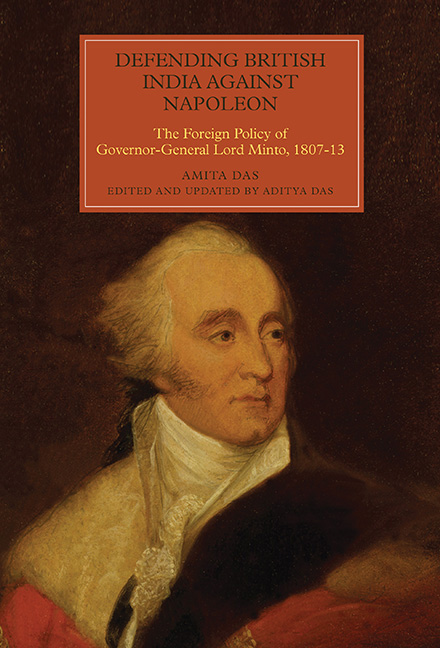Book contents
- Frontmatter
- Dedication
- Contents
- List of Illustrations
- Preface
- Abbreviations
- Chapter 1 Setting the Stage
- Chapter 2 Positioning in Persia
- Chapter 3 Creating a Buffer Zone
- Chapter 4 Protecting Trade and Supply Lines
- Chapter 5 Pre-empting French Influence in Java
- Chapter 6 Legacy of Lord Minto
- Appendix Government of the East India Company
- Bibliography
- Index
- Worlds of the East India Company
Chapter 3 - Creating a Buffer Zone
Published online by Cambridge University Press: 11 May 2021
- Frontmatter
- Dedication
- Contents
- List of Illustrations
- Preface
- Abbreviations
- Chapter 1 Setting the Stage
- Chapter 2 Positioning in Persia
- Chapter 3 Creating a Buffer Zone
- Chapter 4 Protecting Trade and Supply Lines
- Chapter 5 Pre-empting French Influence in Java
- Chapter 6 Legacy of Lord Minto
- Appendix Government of the East India Company
- Bibliography
- Index
- Worlds of the East India Company
Summary
Defending the North-western Frontier of India
Toward the beginning of 1808, Minto decided to open diplomatic relations with Ranjit Singh, the Sikh ruler of Lahore. His objective was to form a defensive alliance against the French. It was believed that an army of invasion from Persia must necessarily march ‘through the Kingdom of Cabul and the territories of Lahore as well as through the countries of several independent Chiefs’ before it could reach the Company's possessions in the Doab.
In a note dated 17 June 1808, Minto wrote:
The more I reflect upon the progressive activity of the intrigues & exertions of the French Embassy in Persia directed to the ultimate execution of their hostile designs against the British possessions in India,… the more I am convinced of the immediate necessity of adopting those additional measures of counteraction which have long been in the Contemplation of Government but of which the actual prosecution has been hitherto suspended by a Consideration of apparent obstacles and difficulties. I allude to the Mission of British agents to the Courts of Lahore and Caubul.
It was believed in India that an attack on the British territories from the north-west might be directed by two possible routes: the northern route through Persia, Kandahar, Kabul and the Punjab into Oudh, and the southern route through Persia, Kabul and Sind into Bombay. The importance of the Sikh country, situated on the banks of the Sutlej, for the defence of the British territories in India was discussed in a memorandum by David Hopkins, a member of the Company's Bengal Medical Establishment. Comparing the potentialities of Sind and the Punjab, Hopkins wrote that Sind was distinguished neither for its wealth nor its strength and was of importance ‘only as it commands the navigation of the river Indus’. The Punjab, on the other hand, not only commanded the upper Indus valley but was ‘uncommonly fertile… and inhabited by a hardy and brave but an uncivilized and rapacious race of people’. An enemy in possession of the Punjab could easily advance upon Delhi. The presence of the French in Persia and a look at the map of India convinced Minto of the necessity of first sending a political mission to Lahore. Minto had to formulate his cis-Sutlej policy shortly after Metcalfe commenced the negotiations with Ranjit Singh.
- Type
- Chapter
- Information
- Defending British India against NapoleonThe Foreign Policy of Governor-General Lord Minto, 1807-13, pp. 91 - 134Publisher: Boydell & BrewerPrint publication year: 2016



